
airgradient_esphome
ESPHome definition for an AirGradient DIY device to send data to HomeAssistant and AirGradient servers
Stars: 268
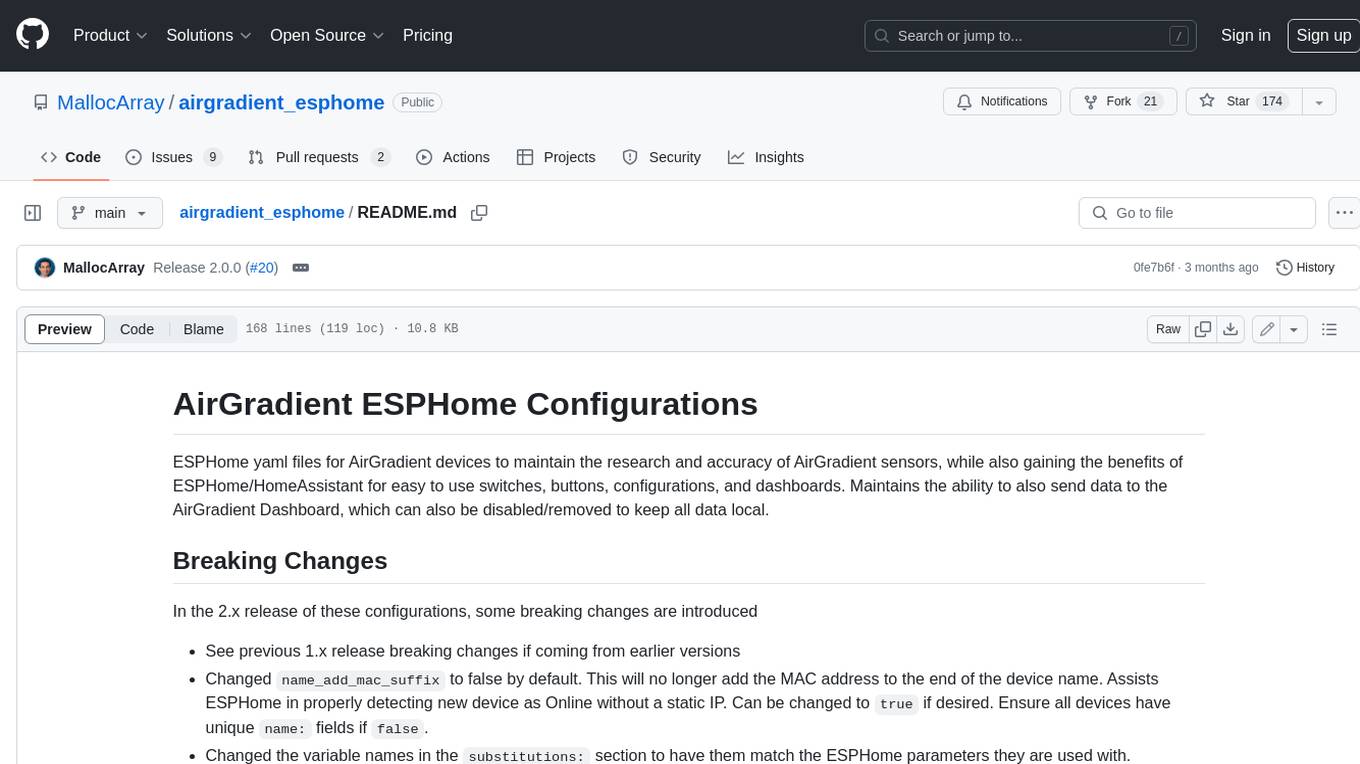
ESPHome yaml files for AirGradient devices to maintain the research and accuracy of AirGradient sensors, while also gaining the benefits of ESPHome/HomeAssistant for easy to use switches, buttons, configurations, and dashboards. Maintains the ability to also send data to the AirGradient Dashboard, which can also be disabled/removed to keep all data local.
README:
ESPHome yaml files for AirGradient devices to maintain the research and accuracy of AirGradient sensors, while also gaining the benefits of ESPHome/HomeAssistant for easy to use switches, buttons, configurations, and dashboards. Maintains the ability to also send data to the AirGradient Dashboard, which can also be disabled/removed to keep all data local.
- 5.0.0 is a major version upgrade as switching to esp-idf is not fully supported via OTA. Highly recommend doing one USB flash of 4.1.0 and later to the AirGradient ONE and OpenAir devices to reformat the storage to support esp-idf. Future updates can be done Over-The-Air without issue.
- It not done, the device is likely to reboot at some point and switch to the standby partition, returning to a version prior to 4.1.0
- Seeing an Old Firmware Version After Update? Here's Why & How to Fix It · Issue #1821 · Blackymas/NSPanel_HA_Blueprint
- Read/Write bootloader, partition table and any partition via OTA by angelnu · Pull Request #5535 · esphome/esphome
- Aware of errors in the logs stating
esp_task_wdt_reconfigure(615): Invalid arguments - 4.1.0 switches ONE and OpenAir models (based on ESP32) to the esp-idf framework, freeing up some memory and allowing other advanced features such as bluetooth_proxy and esp32_improv. If the previous Arduino framework is desired, change the board to
airgradient_esp32-c3_board-arduino.yaml - If attempting to add BT and BLE support, may need to remove the captive_portal package to free up enough space Issue #115
- Remove substitution line such as
config_version: 2.0.5from the main file, as this has been moved into the board package file - Updated to 4.0.0 versions, skipping 3.x to avoid confusion with current AirGradient official firmware
- Now defaulting to https for AirGradient API communication. If older devices (DIY and Pro models) go into constant reboots, switch to the api package
airgradient_api_d1_mini_insecure.yamlto revert to the original communication method
- Support for ESPHome 2025.2 and later due to changes to esp32_rmt_led_strip
- Added extended timeout for API upload on ONE and OpenAir models to reduce reboots
- Applied correction algorithms for PM2.5 provided by AirGradient
- Updated API upload to follow current structure including both raw and corrected values
- Moved config_version substitution into the board package so it can be updated without manual change to main config file. Please remove the line starting with
config_version:from your personal files - Split captive portal config to a separate package. Can be removed if not using the portal or if defining wifi networks in your config file, which results in a small memory savings
- Removed safe_mode package by default. Very few use cases for it
- Added commented out packages for extended_life configs to make it easier to enable if desired
- Added commented out package for SHT30 temp sensor in AG Pro file to make it easier to switch to if desired
- Added new sensor options for raw values for PM2.5, temp, and humidity in some device configurations, and added AirGradient provided correction algorithms to the standard sensors
- AG DIY Basic display config changed to same font as other models, downloading from gfonts instead of using local file
Many added features can be found in HomeAssistant by going to Settings>Devices and selecting the AirGradient device. Alternatively, add web_server: to the config file to enable a built-in web server on the AirGradient device (No recommended for devices based on the D1 Mini ESP8266)
-
Compact single page display by default with all relevant sensor readings
-
Display Contrast slider to dim the display
-
Enable different pages of information to be shown on the OLED display, or leave the default of a single page with all relevant information
-
Button to initiate a SenseAir S8 CO2 Calibration on demand
-
Switch to enable or disable SenseAir S8 CO2 sensor Automatic Baseline Calibration (ABC)
-
Button to view the current S8 ABC interval (confirm if ABC is disabled or enable, which defaults to every 7 days) View ESPHome logs to see the output of this button
-
Switch to disable LED output on AirGradient ONE model
-
Brightness slider to adjust intensity of AirGradient ONE LED
-
Switch to toggle display between Fahrenheit and Celsius and persist between reboots
-
Switch to enable or disable uploading to AirGradient Dashboard via API (Choose to keep data local or also send to AirGradient)
-
Utilize hardware configuration buttons on AirGradient Pro v3.7 and higher
- Short press (Less than 1 second) - Toggle between F and C on display
- Long press (More than 1 second, less than 5) - Trigger manual CO2 calibration
-
Leverage automation in HomeAssistant to turn on the "Blank" page and turn off all other pages to effectively disable the display output. Could also turn off the LED strip or set Brightness to 0 to eliminate output while still collecting sensor data
- In ESPHome web interface, click New Device. Give any name. Select any model of board, and click Skip on the final page to not install at this time. Click Edit on the new entry and replace with the contents of the .yaml file for your model.
- Alternatively, copy the .yaml file from the main folder for your model in this repo and place it in the
configfolder of your ESPHome. - Make any desired changes to the substitutions to name the devices for your use case
- Install to the device using one of the ESPHome options.
Note: by default ESPHome only syncs remote repositories that the packages are referencing once per day, so if changes are made to the repository, you may not get the updated config for up to 1 day after it is published. You can remove the contents of the folder config/.esphome/packages to force it to update sooner
Note: setting
add_mac_suffix: "true"allows for multiple devices on your network at the same time and report as unique entries even if yourname:field is duplicated, but it can cause ESPHome to not detect devices as Online after installing, since ESPHome is looking for only thename:field and the actual device name has the MAC address added to the endOne way to resolve this is to change
add_mac_suffix: "false"so the device name will match exactly. If you have multiple devices, make sure to change thename:field to be unique for each deviceAnother alternative is to add a static IP to the wifi configuration and configure ESPHome to ping the device by IP instead of hostname
Dashboard status light not working across subnets/zones · Issue #641 · esphome/issues (github.com)
Example for static IP
wifi: ssid: !secret wifi_ssid password: !secret wifi_password manual_ip: static_ip: 192.168.1.121 gateway: 192.168.1.1 subnet: 255.255.255.0 dns1: 192.168.1.1
Install a compiled file to your device all with just a browser and USB cable, no ESPHome install required.
Save the appropriate .bin file and go to https://web.esphome.io/ in your browser to connect your ESP device and send the .bin file to it
In some cases, the device may encounter errors using the web flash tool. Steps to put the device in a special boot flash mode can be found here: https://forum.airgradient.com/t/airgradient-one-not-working-after-flashing-with-arduino/1326/4
The full_config folder contains a single yaml file per model that contains the full standalone configuration, created by the esphome config command. This adds in all of the optional parameters, so is much longer than the minimum configuration, but the single file contains all needed information to be completely independent from this repo.
Copy the full config file to your personal ESPhome config file and customize as desired, then install to your device.
If some sensors are not showing valid readings after installing or upgrading, please remove the power cable from the device entirely for 5-10 seconds, then reconnect. Many issues are resolved with a full power reset, as the software reset does not fully clear some situations.
If all original sensors (PMS5003, Senseair S8, SHT4x) are connected, configuration files should be ready for use.
If some sensors are not installed, comment or remove the associated sections under packages:
The PMS5003 sensor by default collects readings every second. Since this device has a limited lifespan, it is possible to extend the life by collecting readings less frequently, although this could impact the accuracy of the readings collected, since there will not be constant airflow through the device when the fan shuts down. To collect readings every 2 minutes, change the line for the pms5003 sensor to sensor_pms5003_extended_life.yaml
See PMSX003 Particulate Matter Sensor — ESPHome for more information
To add your WiFi SSID and password, add your SSID and password information, per ESPHome specifications
wifi:
ssid: NachoWiFi
password: 123456123456By default, packages are referencing this GitHub repository, allowing you to do a new Install from ESPHome dashboard to get the latest modifications without downloading other files, but does require an Internet connection. If you wish to have more control over modifications or only reference local files, copy the packages folder to your local ESPHome folder in a packages subfolder and replace github://MallocArray/airgradient_esphome/packages with !include packages
# Example
board: github://MallocArray/airgradient_esphome/packages/sensor_s8.yaml
# becomes
board: !include packages/sensor_s8.yamlRather than download an individual package and update the reference to it, you may also use the Extend option to make minor modifications without editing the packages file. This only works for items with and id: defined
Example: adding this to the main file for your device will change the pin number in the config_button package, while maintaining all other settings defined in the package
binary_sensor: - id: !extend config_button pin: number: D7
It is also possible to copy the contents of a package file and paste it directly into your YAML file. Do note that sections cannot be duplicated, so if multiple sections like interval are pasted in, they must be combined into a single entry when using this method.
Several additional packages are available in the packages folder that can be added or removed as needed. See the Packages page for more information about available options.
MQTT support has been mentioned in the AirGradient forums several times. ESPHome supports this by adding a few lines to the main yaml file. Add the relevant information for your configuration. Read more about it here: https://esphome.io/components/mqtt.html
Several more features are planned to be added to this repo
- [ ] Explore options for disabling display/LED during certain times (May be differed to HomeAssistant Automation)
- [X] Standardize font on AirGradient Basic display to match Pro
For Tasks:
Click tags to check more tools for each tasksFor Jobs:
Alternative AI tools for airgradient_esphome
Similar Open Source Tools

airgradient_esphome
ESPHome yaml files for AirGradient devices to maintain the research and accuracy of AirGradient sensors, while also gaining the benefits of ESPHome/HomeAssistant for easy to use switches, buttons, configurations, and dashboards. Maintains the ability to also send data to the AirGradient Dashboard, which can also be disabled/removed to keep all data local.
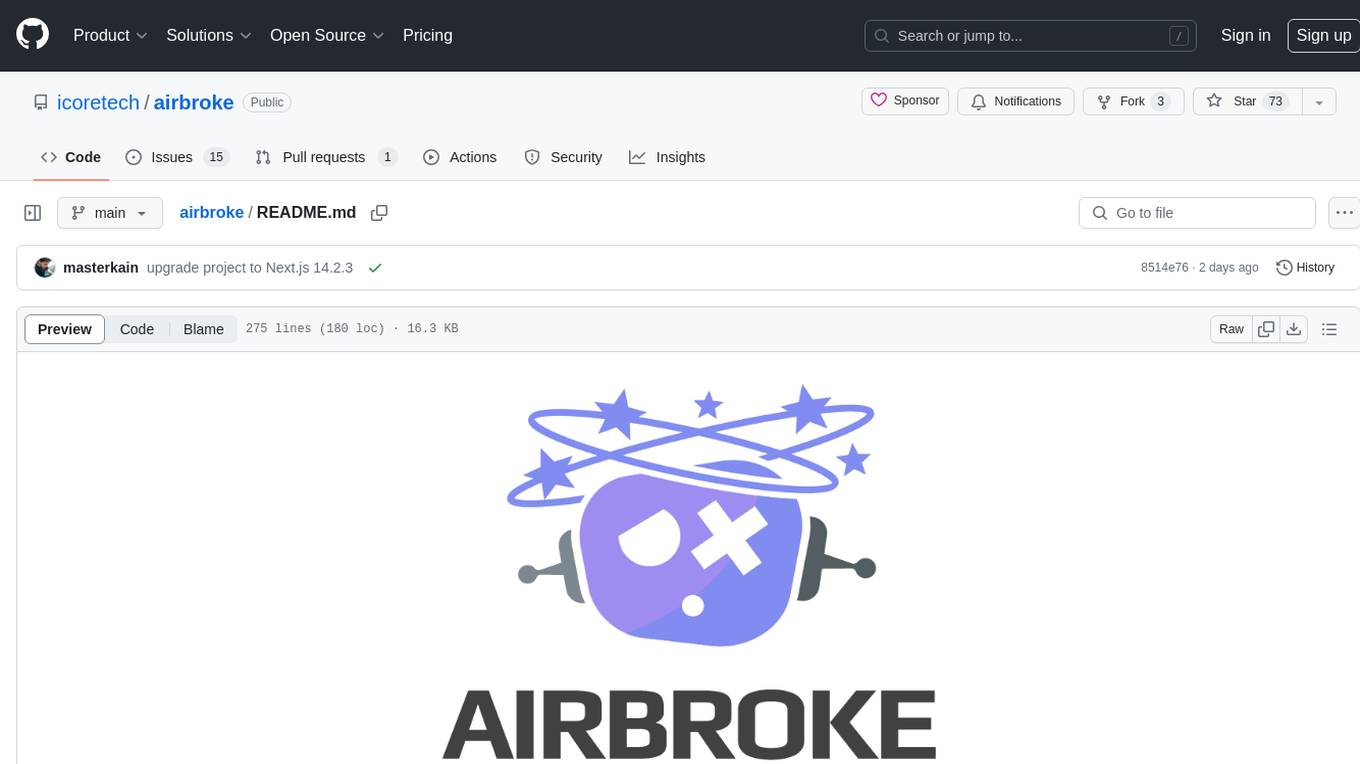
airbroke
Airbroke is an open-source error catcher tool designed for modern web applications. It provides a PostgreSQL-based backend with an Airbrake-compatible HTTP collector endpoint and a React-based frontend for error management. The tool focuses on simplicity, maintaining a small database footprint even under heavy data ingestion. Users can ask AI about issues, replay HTTP exceptions, and save/manage bookmarks for important occurrences. Airbroke supports multiple OAuth providers for secure user authentication and offers occurrence charts for better insights into error occurrences. The tool can be deployed in various ways, including building from source, using Docker images, deploying on Vercel, Render.com, Kubernetes with Helm, or Docker Compose. It requires Node.js, PostgreSQL, and specific system resources for deployment.

lumigator
Lumigator is an open-source platform developed by Mozilla.ai to help users select the most suitable language model for their specific needs. It supports the evaluation of summarization tasks using sequence-to-sequence models such as BART and BERT, as well as causal models like GPT and Mistral. The platform aims to make model selection transparent, efficient, and empowering by providing a framework for comparing LLMs using task-specific metrics to evaluate how well a model fits a project's needs. Lumigator is in the early stages of development and plans to expand support to additional machine learning tasks and use cases in the future.
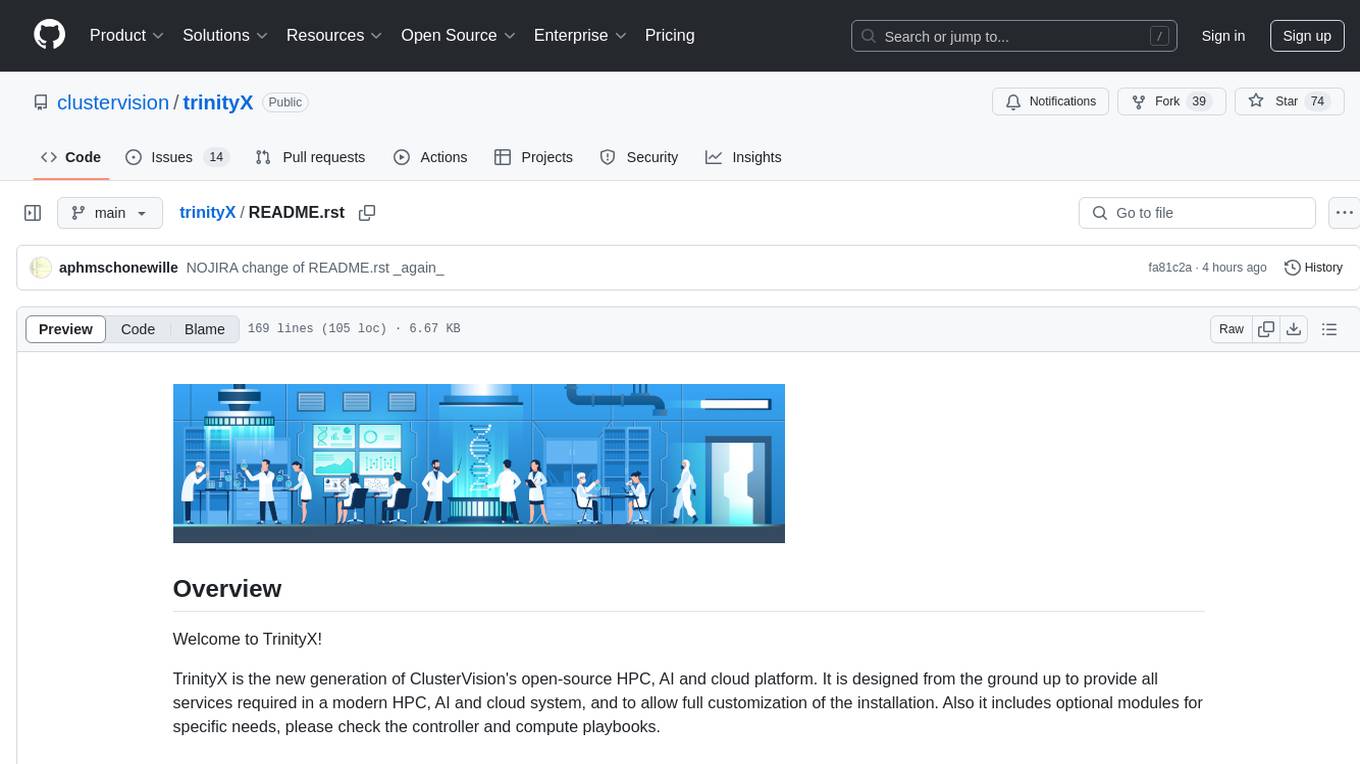
trinityX
TrinityX is an open-source HPC, AI, and cloud platform designed to provide all services required in a modern system, with full customization options. It includes default services like Luna node provisioner, OpenLDAP, SLURM or OpenPBS, Prometheus, Grafana, OpenOndemand, and more. TrinityX also sets up NFS-shared directories, OpenHPC applications, environment modules, HA, and more. Users can install TrinityX on Enterprise Linux, configure network interfaces, set up passwordless authentication, and customize the installation using Ansible playbooks. The platform supports HA, OpenHPC integration, and provides detailed documentation for users to contribute to the project.
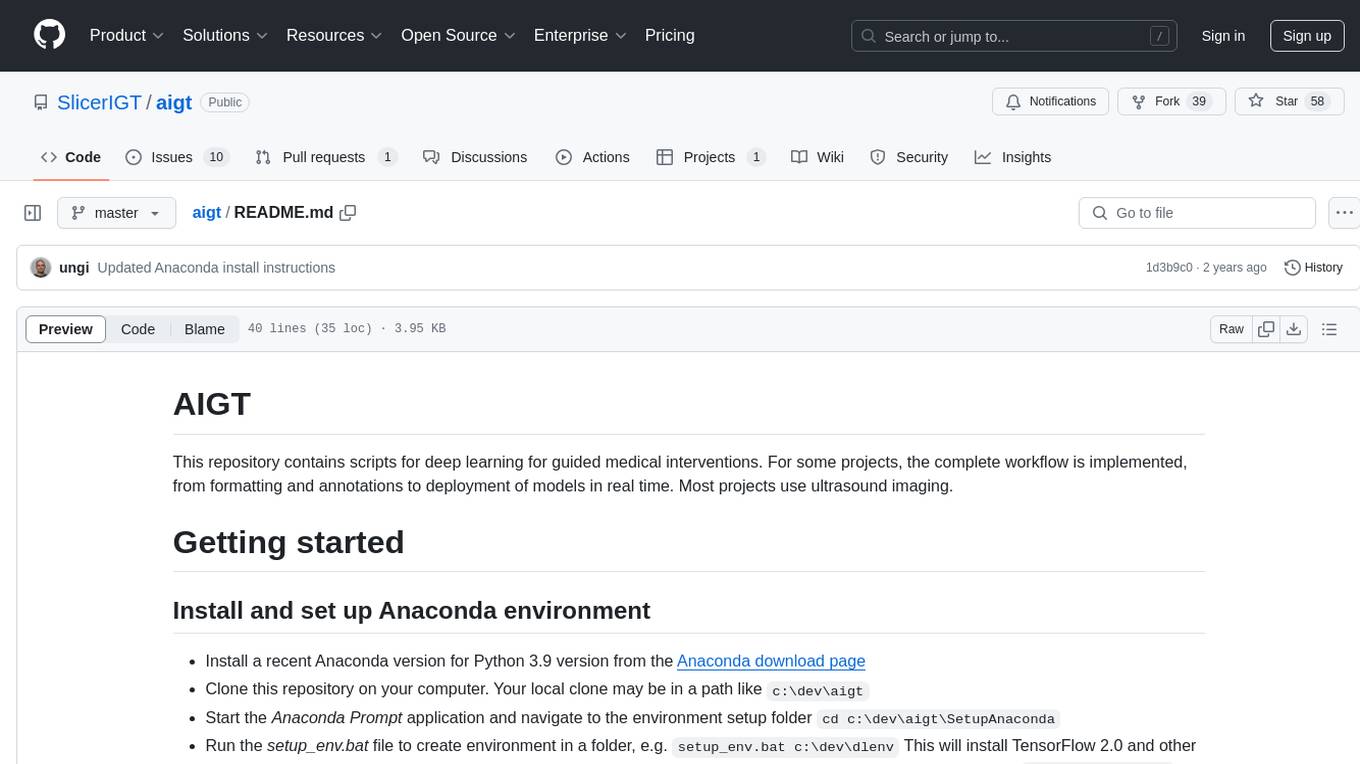
aigt
AIGT is a repository containing scripts for deep learning in guided medical interventions, focusing on ultrasound imaging. It provides a complete workflow from formatting and annotations to real-time model deployment. Users can set up an Anaconda environment, run Slicer notebooks, acquire tracked ultrasound data, and process exported data for training. The repository includes tools for segmentation, image export, and annotation creation.
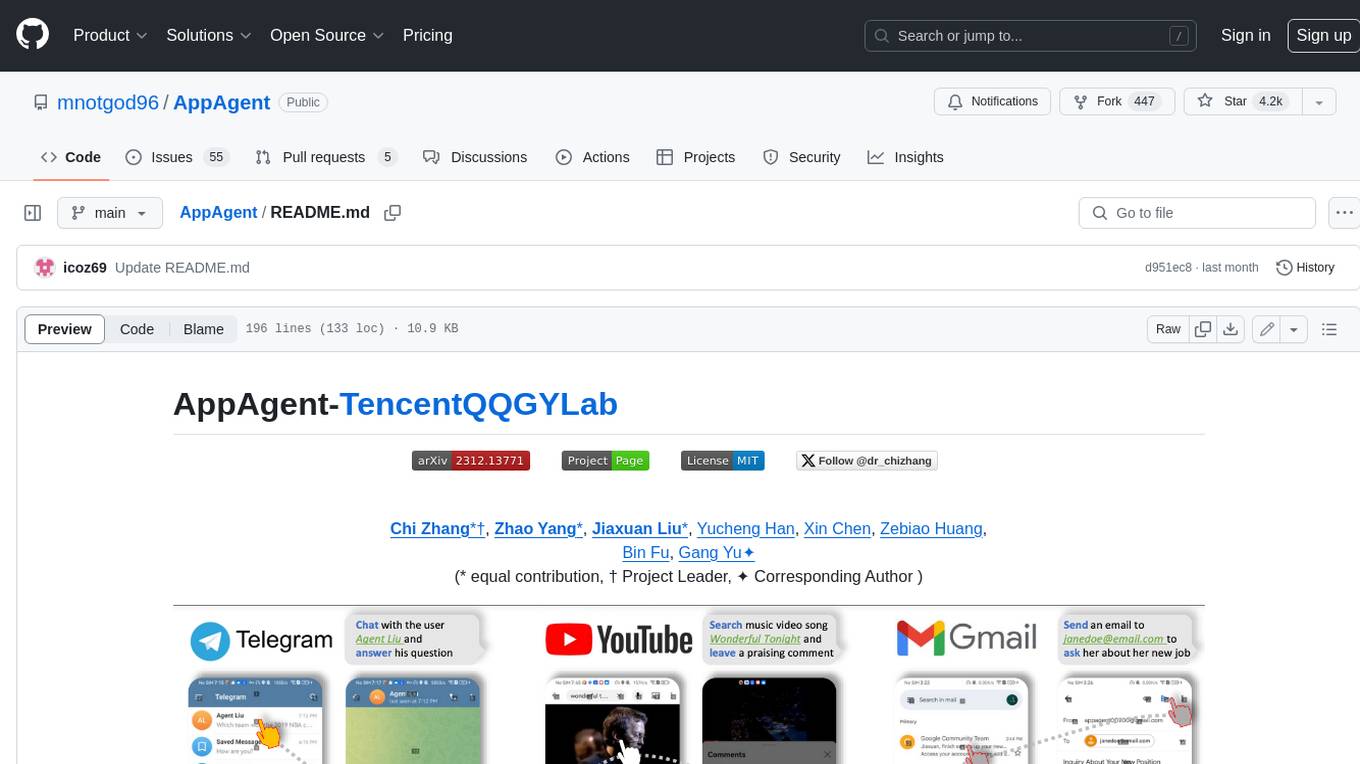
AppAgent
AppAgent is a novel LLM-based multimodal agent framework designed to operate smartphone applications. Our framework enables the agent to operate smartphone applications through a simplified action space, mimicking human-like interactions such as tapping and swiping. This novel approach bypasses the need for system back-end access, thereby broadening its applicability across diverse apps. Central to our agent's functionality is its innovative learning method. The agent learns to navigate and use new apps either through autonomous exploration or by observing human demonstrations. This process generates a knowledge base that the agent refers to for executing complex tasks across different applications.
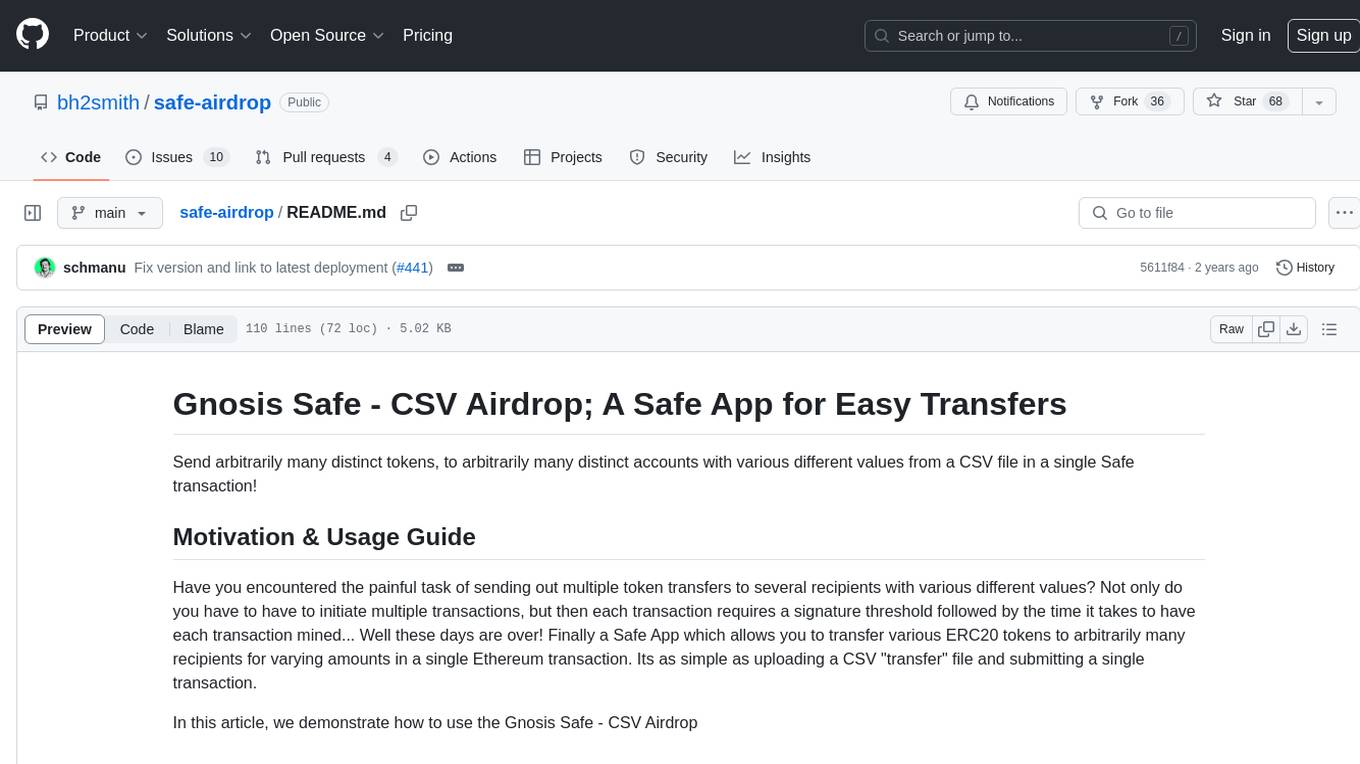
safe-airdrop
The Gnosis Safe - CSV Airdrop is a Safe App designed to simplify the process of sending multiple token transfers to various recipients with different values in a single Ethereum transaction. Users can upload a CSV transfer file containing receiver addresses, token addresses, and transfer amounts. The app eliminates the need for multiple transactions and signature thresholds, streamlining the airdrop process. It also supports native token transfers and provides a user-friendly interface for initiating transactions. Developers can customize and deploy the app for specific use cases.
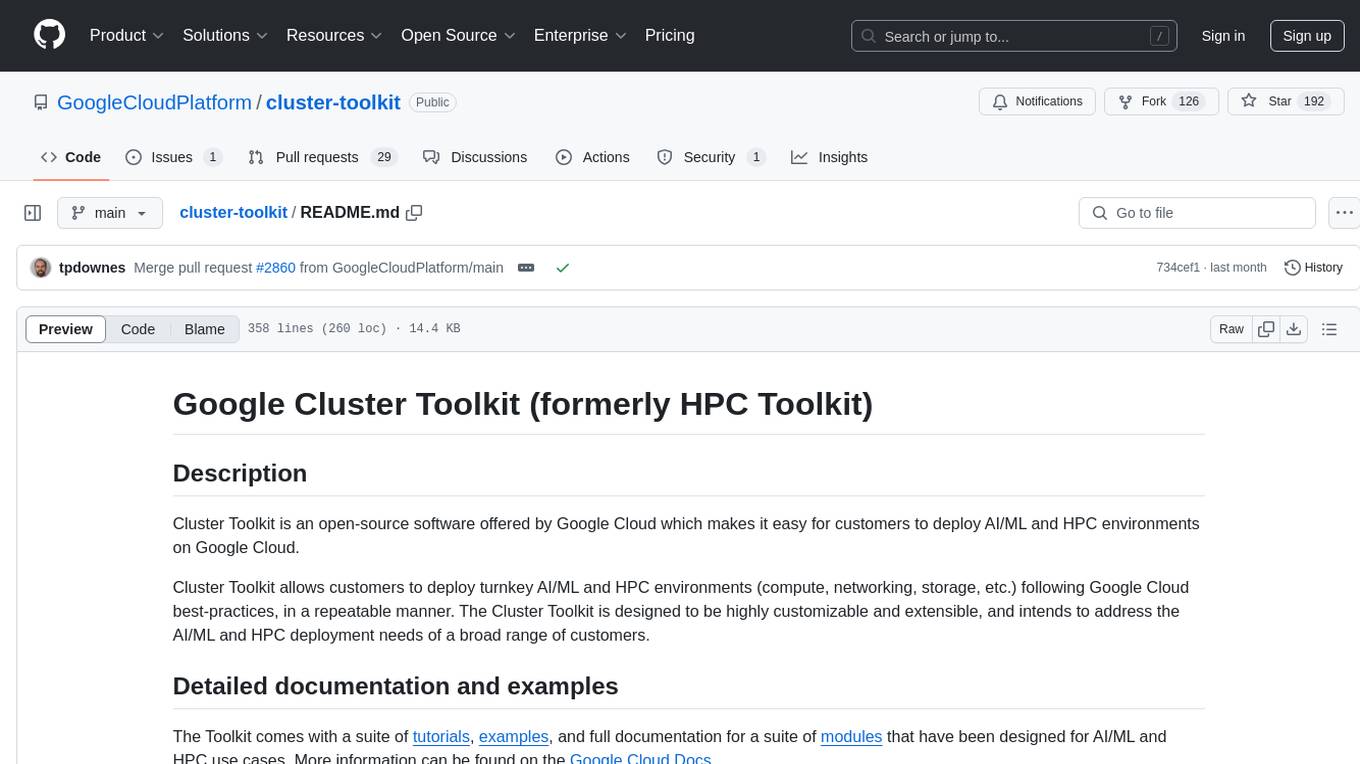
cluster-toolkit
Cluster Toolkit is an open-source software by Google Cloud for deploying AI/ML and HPC environments on Google Cloud. It allows easy deployment following best practices, with high customization and extensibility. The toolkit includes tutorials, examples, and documentation for various modules designed for AI/ML and HPC use cases.
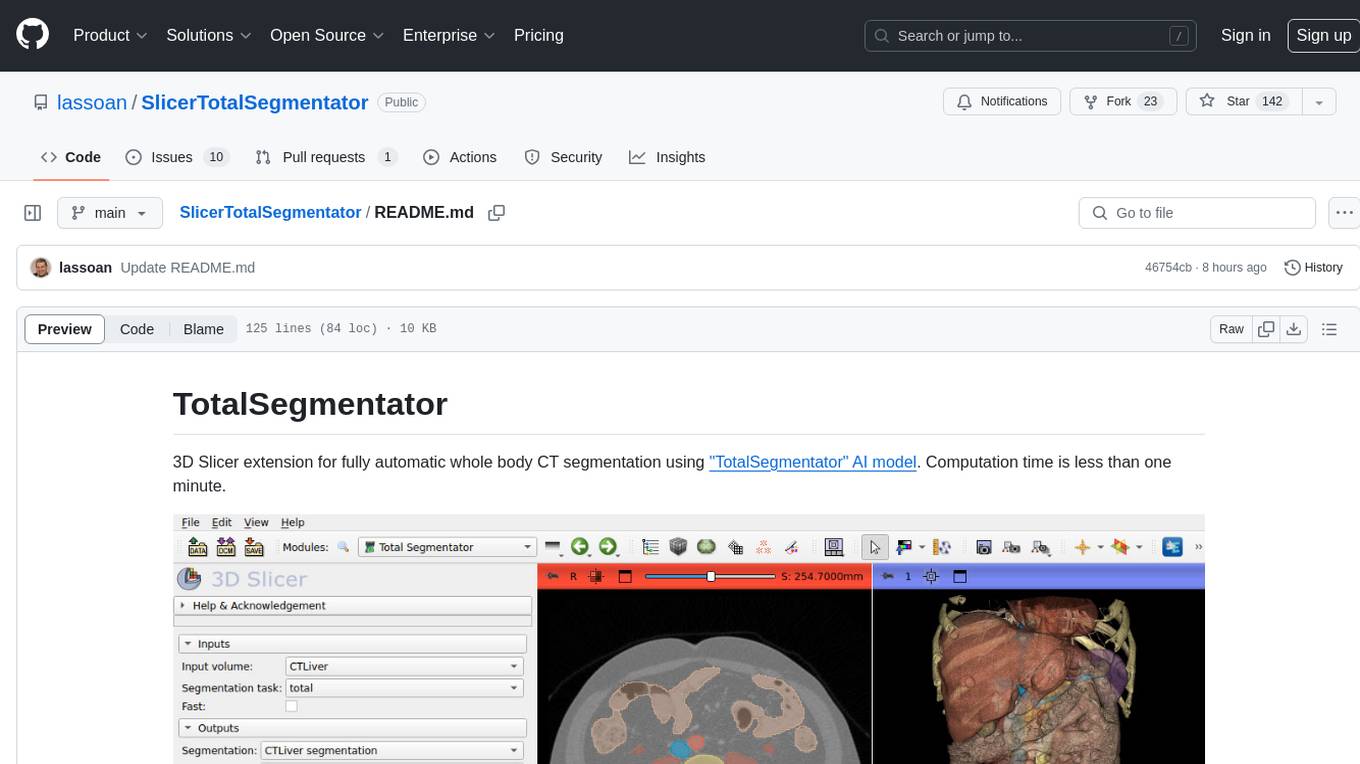
SlicerTotalSegmentator
TotalSegmentator is a 3D Slicer extension designed for fully automatic whole body CT segmentation using the 'TotalSegmentator' AI model. The computation time is less than one minute, making it efficient for research purposes. Users can set up GPU acceleration for faster segmentation. The tool provides a user-friendly interface for loading CT images, creating segmentations, and displaying results in 3D. Troubleshooting steps are available for common issues such as failed computation, GPU errors, and inaccurate segmentations. Contributions to the extension are welcome, following 3D Slicer contribution guidelines.
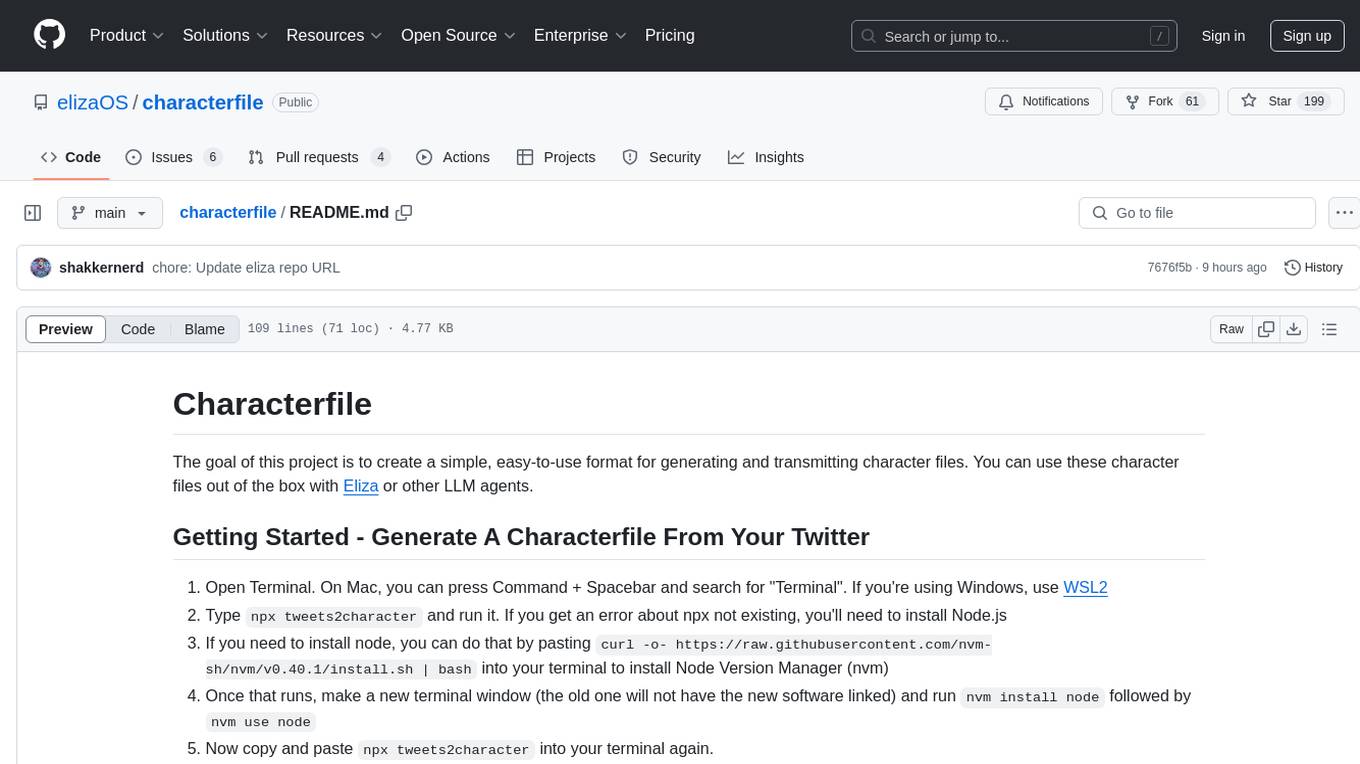
characterfile
The Characterfile project aims to create a simple format for generating and transmitting character files, compatible with Eliza and other LLM agents. Users can convert their Twitter archive into a character file using the provided scripts. The project also includes examples, JSON schema, and TypeScript types for the character file. Scripts like tweets2character, folder2knowledge, and knowledge2character facilitate the conversion of tweets, documents, and knowledge files into character files for use with AI agents.
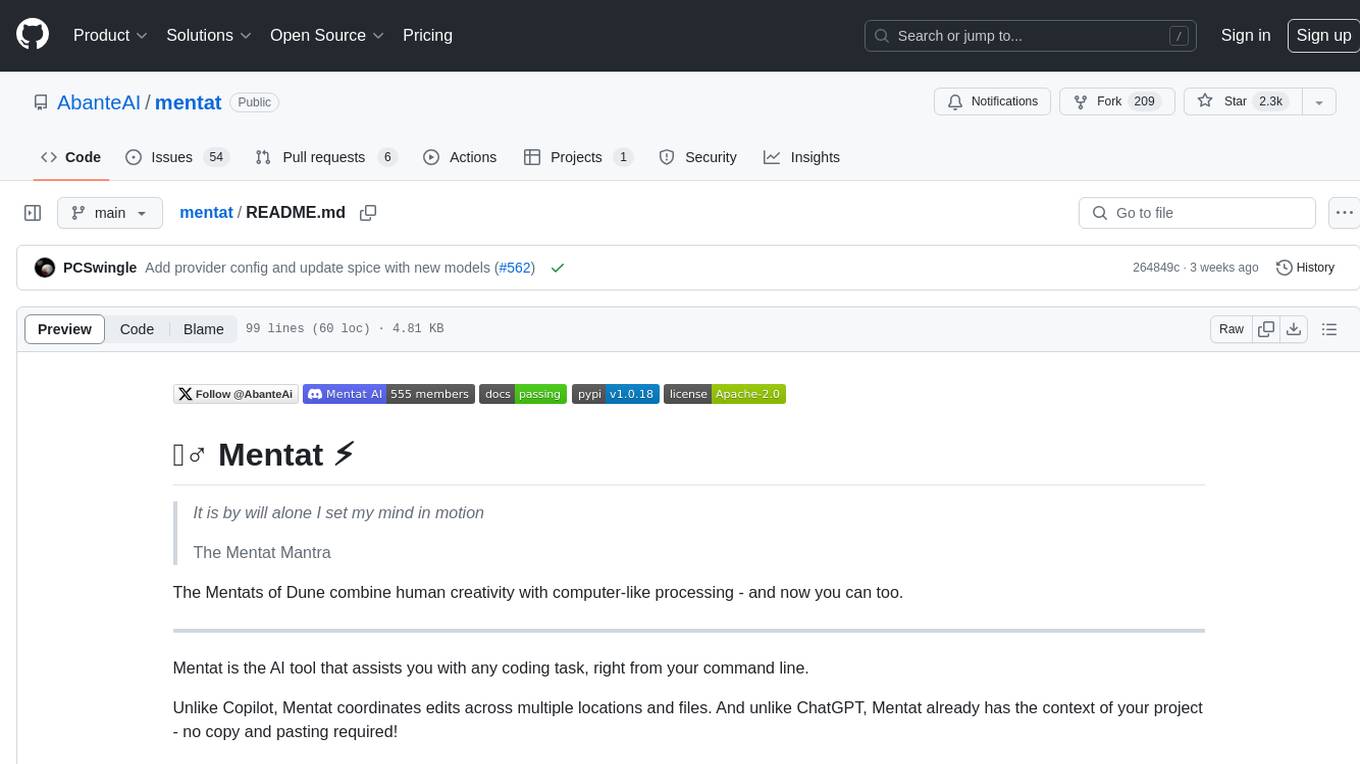
mentat
Mentat is an AI tool designed to assist with coding tasks directly from the command line. It combines human creativity with computer-like processing to help users understand new codebases, add new features, and refactor existing code. Unlike other tools, Mentat coordinates edits across multiple locations and files, with the context of the project already in mind. The tool aims to enhance the coding experience by providing seamless assistance and improving edit quality.
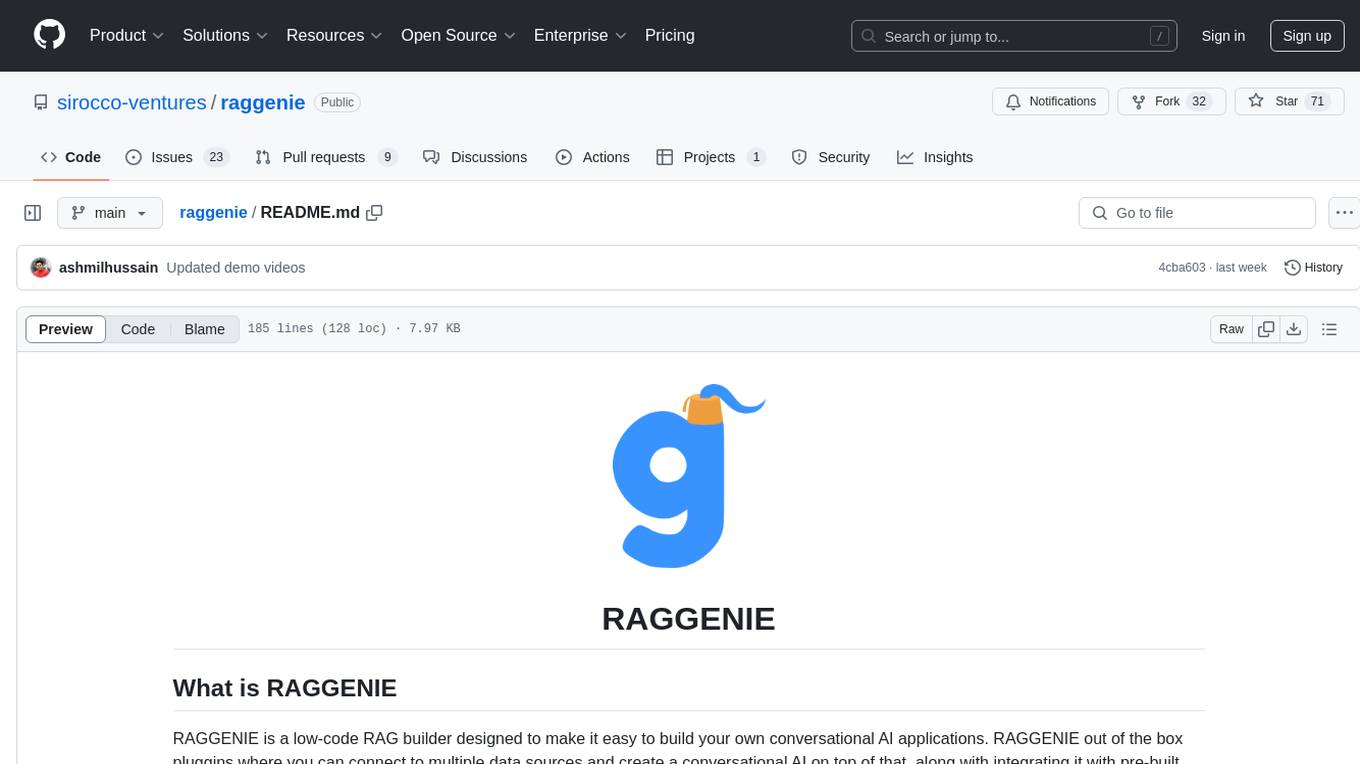
raggenie
RAGGENIE is a low-code RAG builder tool designed to simplify the creation of conversational AI applications. It offers out-of-the-box plugins for connecting to various data sources and building conversational AI on top of them, including integration with pre-built agents for actions. The tool is open-source under the MIT license, with a current focus on making it easy to build RAG applications and future plans for maintenance, monitoring, and transitioning applications from pilots to production.
airgeddon-plugins
airgeddon-plugins is a collection of plugins for the airgeddon tool, designed to enhance its functionality and address specific issues related to wireless network security. These plugins include features such as performing dictionary online attacks on WPA3 networks, allowing all characters on Captive Portal passwords, and fixing compatibility issues with certain Realtek chipsets. The plugins are designed to be deployed within the airgeddon tool directory, providing additional capabilities and options for users.

browser-copilot
Browser Copilot is a browser extension that enables users to utilize AI assistants for various web application tasks. It provides a versatile UI and framework to implement copilots that can automate tasks, extract information, interact with web applications, and utilize service APIs. Users can easily install copilots, start chats, save prompts, and toggle the copilot on or off. The project also includes a sample copilot implementation for testing purposes and encourages community contributions to expand the catalog of copilots.
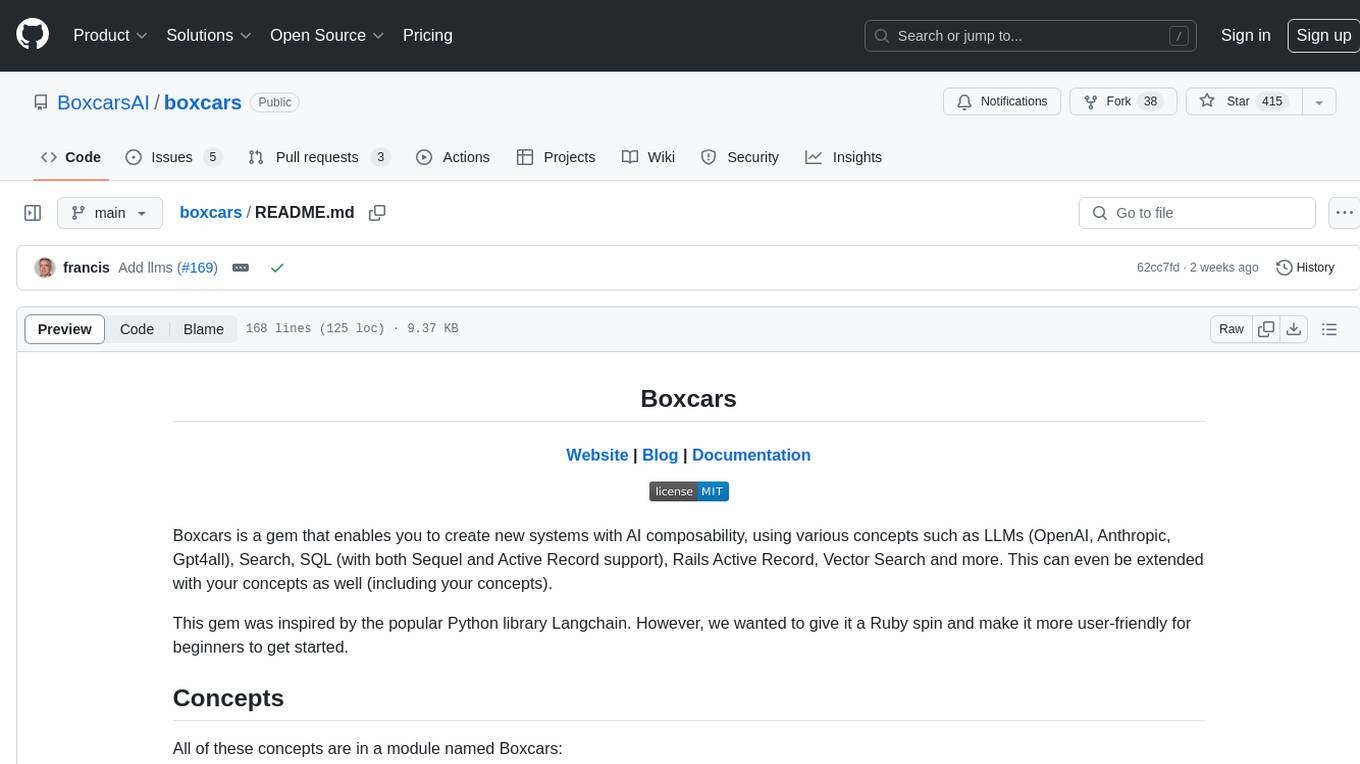
boxcars
Boxcars is a Ruby gem that enables users to create new systems with AI composability, incorporating concepts such as LLMs, Search, SQL, Rails Active Record, Vector Search, and more. It allows users to work with Boxcars, Trains, Prompts, Engines, and VectorStores to solve problems and generate text results. The gem is designed to be user-friendly for beginners and can be extended with custom concepts. Boxcars is actively seeking ways to enhance security measures to prevent malicious actions. Users can use Boxcars for tasks like running calculations, performing searches, generating Ruby code for math operations, and interacting with APIs like OpenAI, Anthropic, and Google SERP.
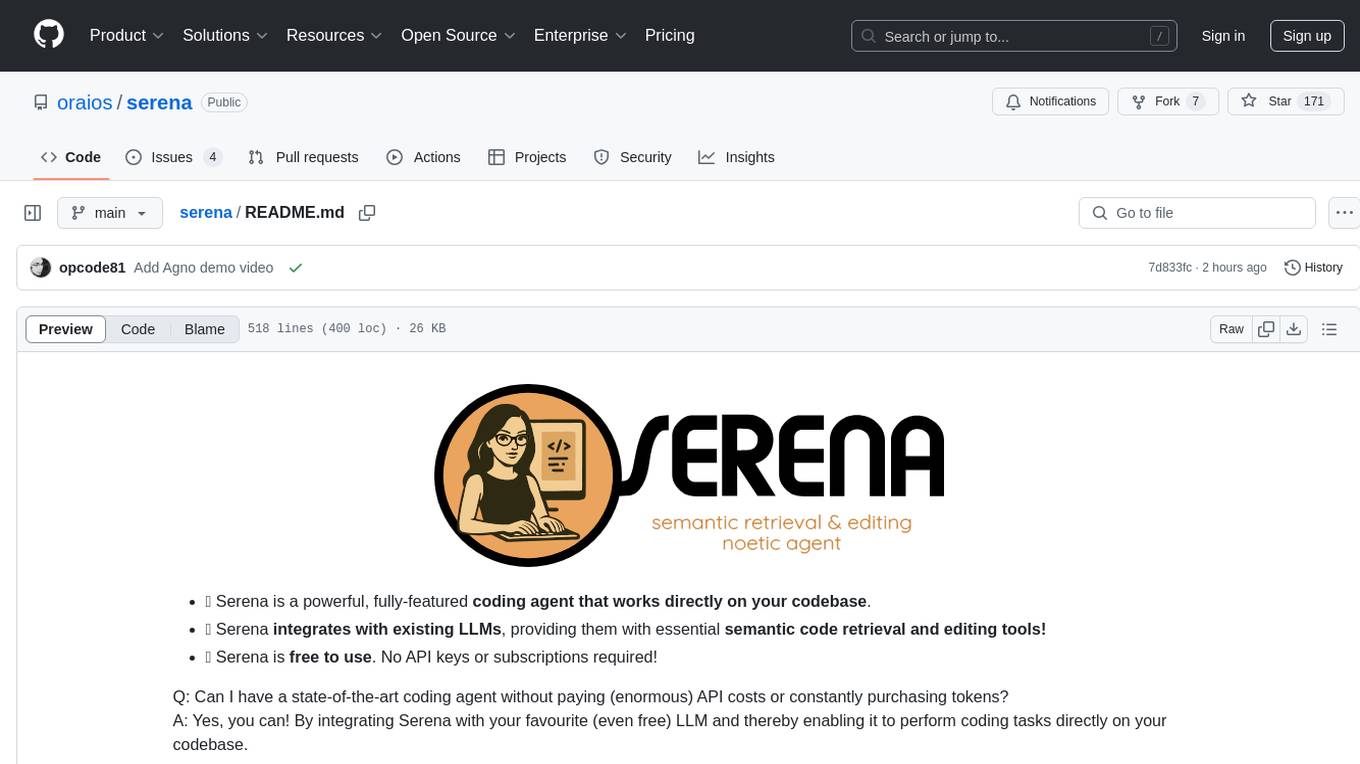
serena
Serena is a powerful coding agent that integrates with existing LLMs to provide essential semantic code retrieval and editing tools. It is free to use and does not require API keys or subscriptions. Serena can be used for coding tasks such as analyzing, planning, and editing code directly on your codebase. It supports various programming languages and offers semantic code analysis capabilities through language servers. Serena can be integrated with different LLMs using the model context protocol (MCP) or Agno framework. The tool provides a range of functionalities for code retrieval, editing, and execution, making it a versatile coding assistant for developers.
For similar tasks
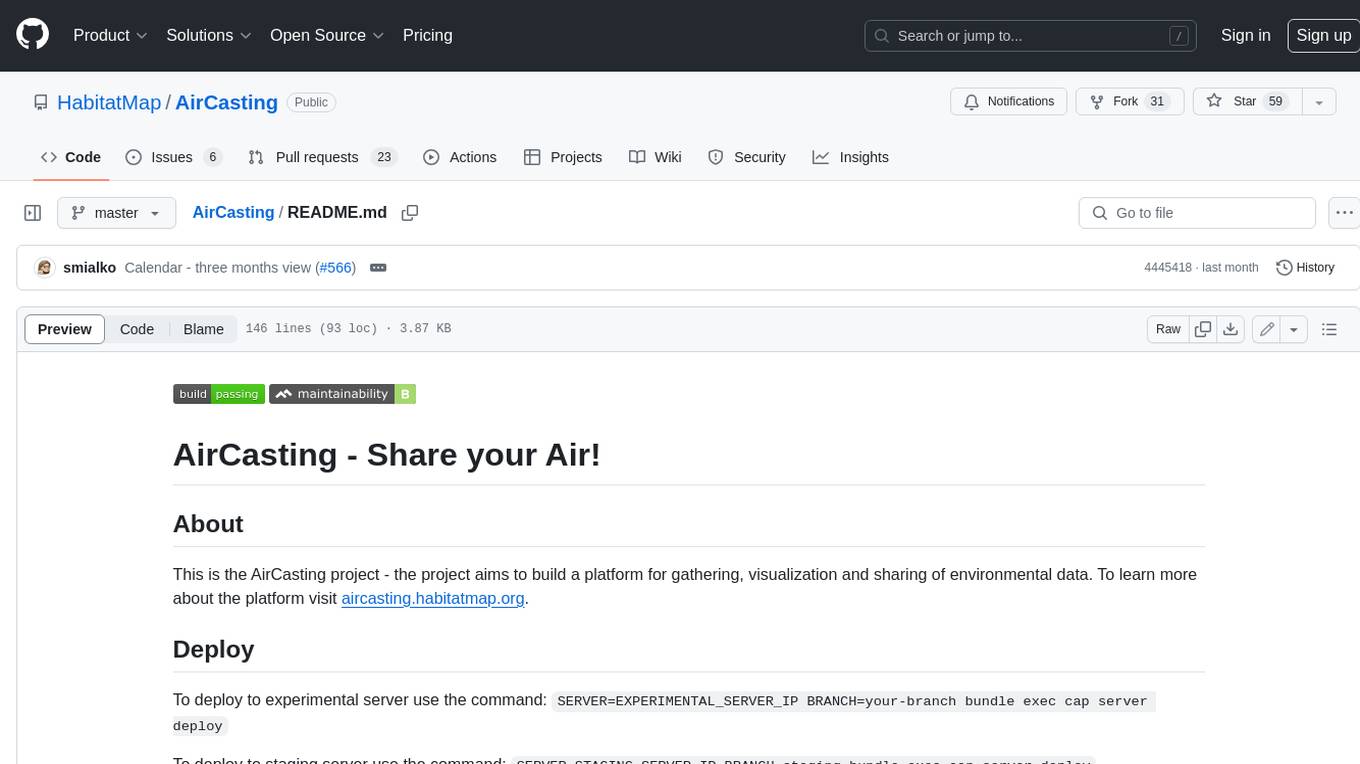
AirCasting
AirCasting is a platform for gathering, visualizing, and sharing environmental data. It aims to provide a central hub for environmental data, making it easier for people to access and use this information to make informed decisions about their environment.

airgradient_esphome
ESPHome yaml files for AirGradient devices to maintain the research and accuracy of AirGradient sensors, while also gaining the benefits of ESPHome/HomeAssistant for easy to use switches, buttons, configurations, and dashboards. Maintains the ability to also send data to the AirGradient Dashboard, which can also be disabled/removed to keep all data local.
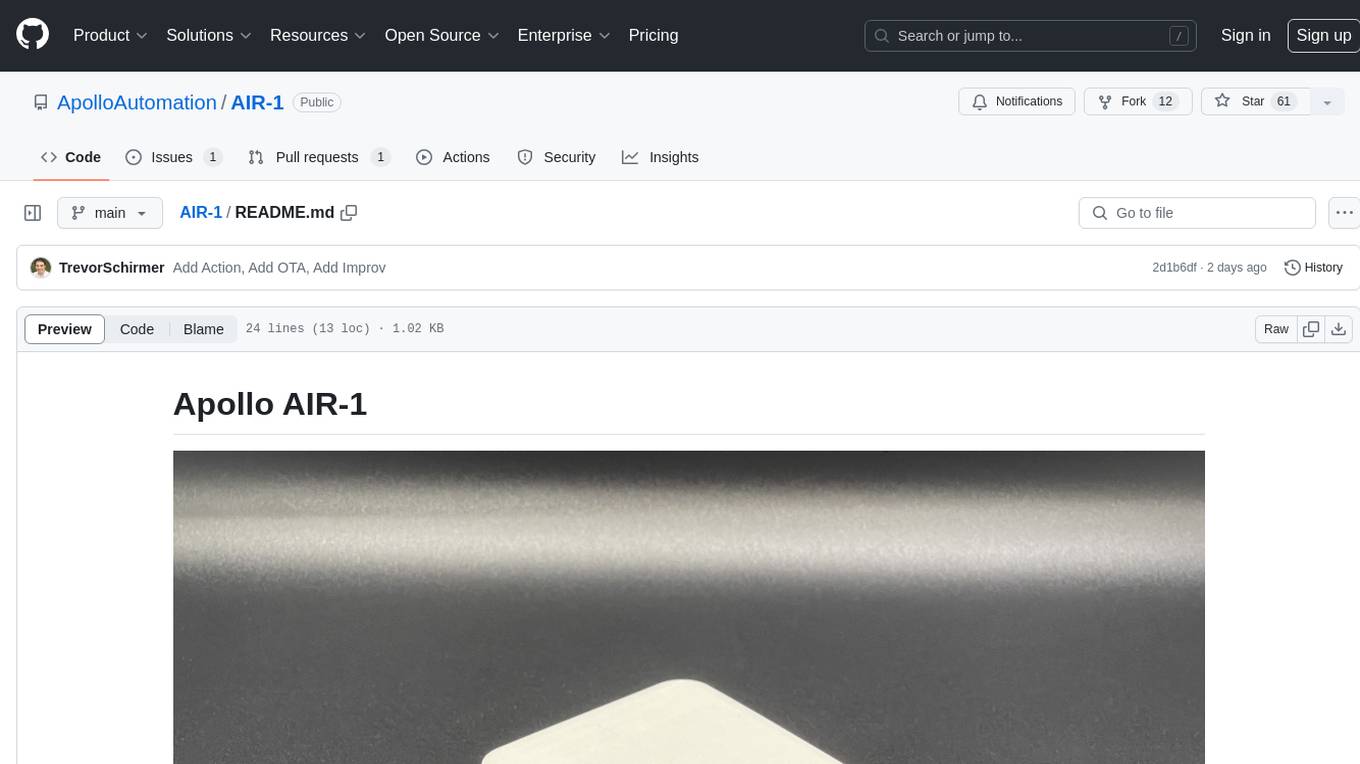
AIR-1
AIR-1 is a compact sensor device designed for monitoring various environmental parameters such as gas levels, particulate matter, temperature, and humidity. It features multiple sensors for detecting gases like CO, alcohol, H2, NO2, NH3, CO2, as well as particulate matter, VOCs, NOx, and more. The device is designed with a focus on accuracy and efficient heat management in a small form factor, making it suitable for indoor air quality monitoring and environmental sensing applications.
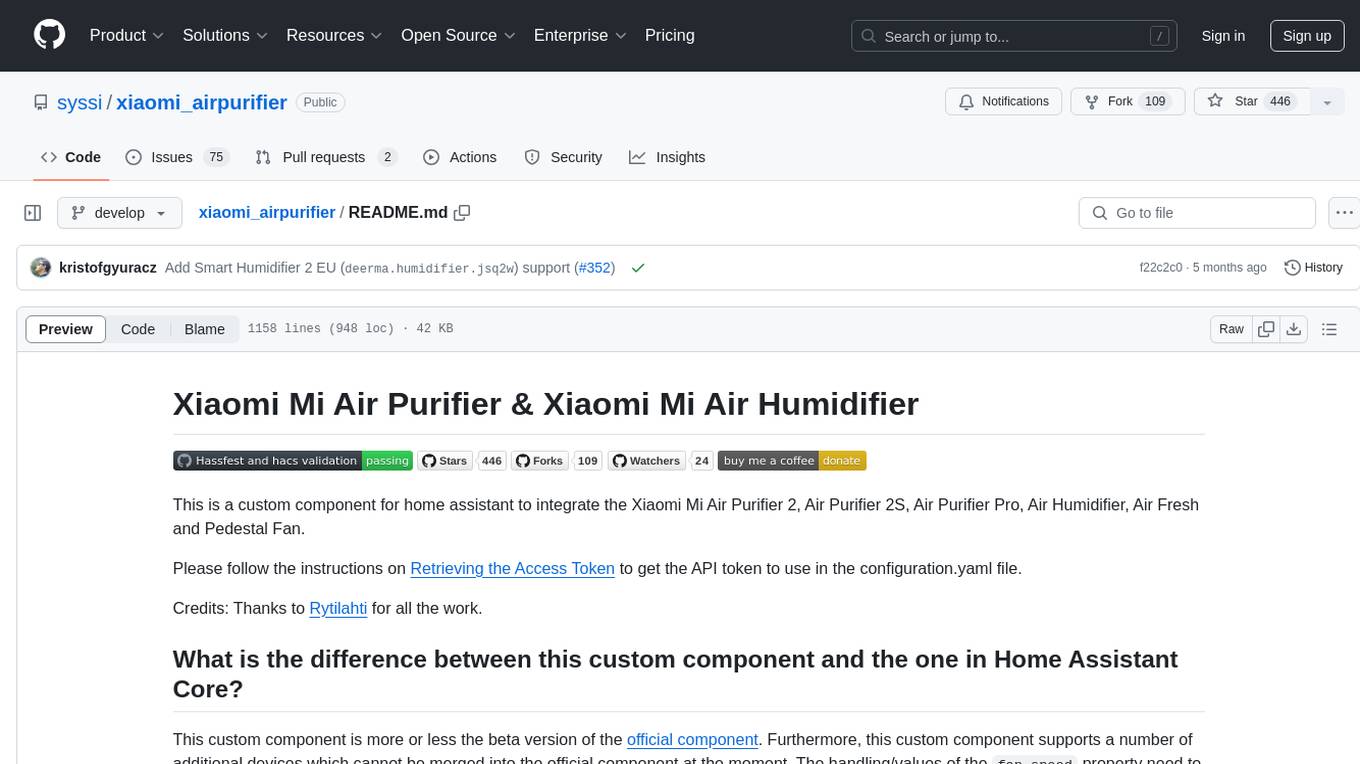
xiaomi_airpurifier
This repository contains a custom component for Home Assistant that integrates various Xiaomi Mi Air Purifier and Xiaomi Mi Air Humidifier models. It provides detailed support for different devices, including power control, preset modes, child lock, LED control, favorite level adjustment, and various attributes monitoring. The custom component offers a more extensive range of supported devices compared to the official Home Assistant component, with additional features and device compatibility. Users can easily set up and configure their Xiaomi air purifiers and humidifiers within Home Assistant for enhanced control and monitoring.
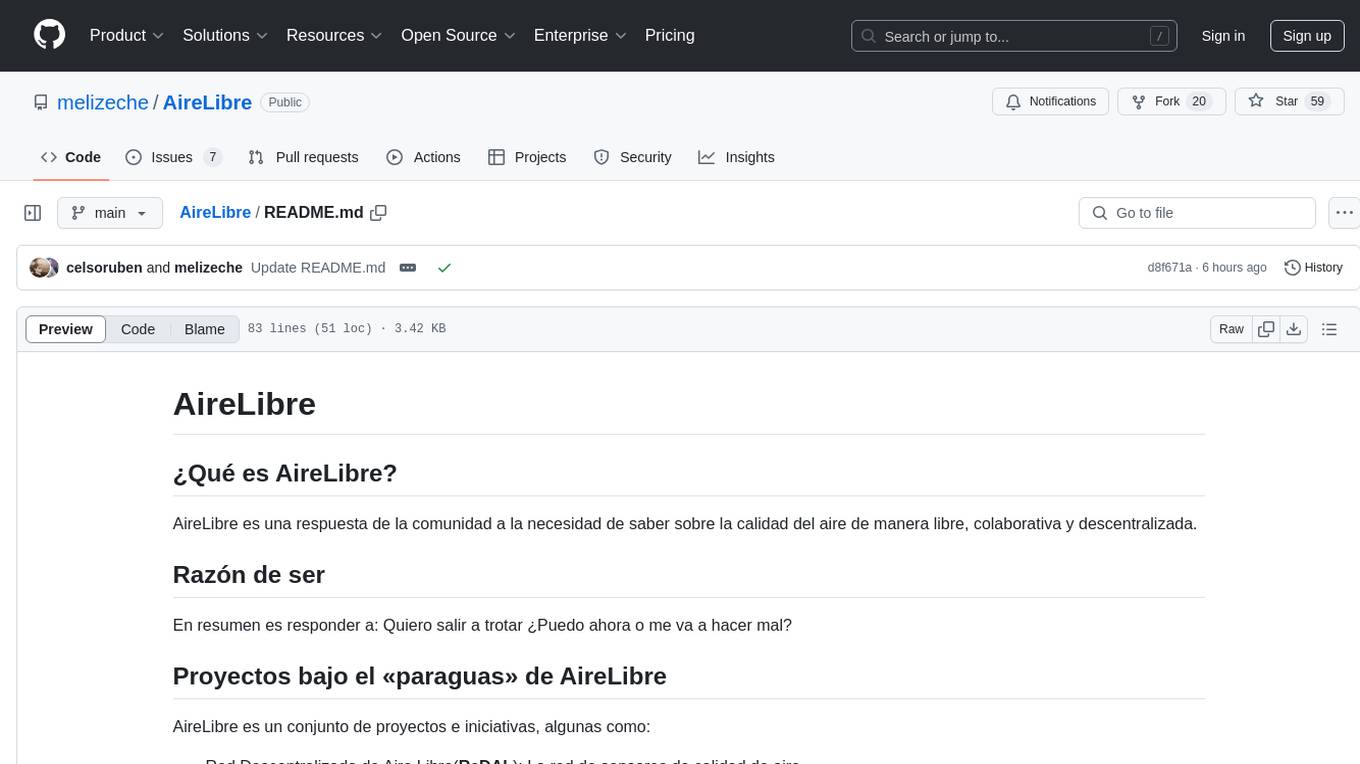
AireLibre
AireLibre is a community response to the need for freely, collaboratively, and decentralized air quality information. It includes projects like Red Descentralizada de Aire Libre (ReDAL), Linka, Linka Firmware, LinkaBot, AQmap, and Android/iOS apps. Users can join the network with a sensor communicating with Linka. Materials and tools are needed to build a sensor. The initiative is decentralized and open for community collaboration. Users can extend or add projects to AireLibre. The license allows for creating personal networks. AireLibre is not for professional/industrial/scientific/military use, and the sensors are not calibrated in Switzerland.
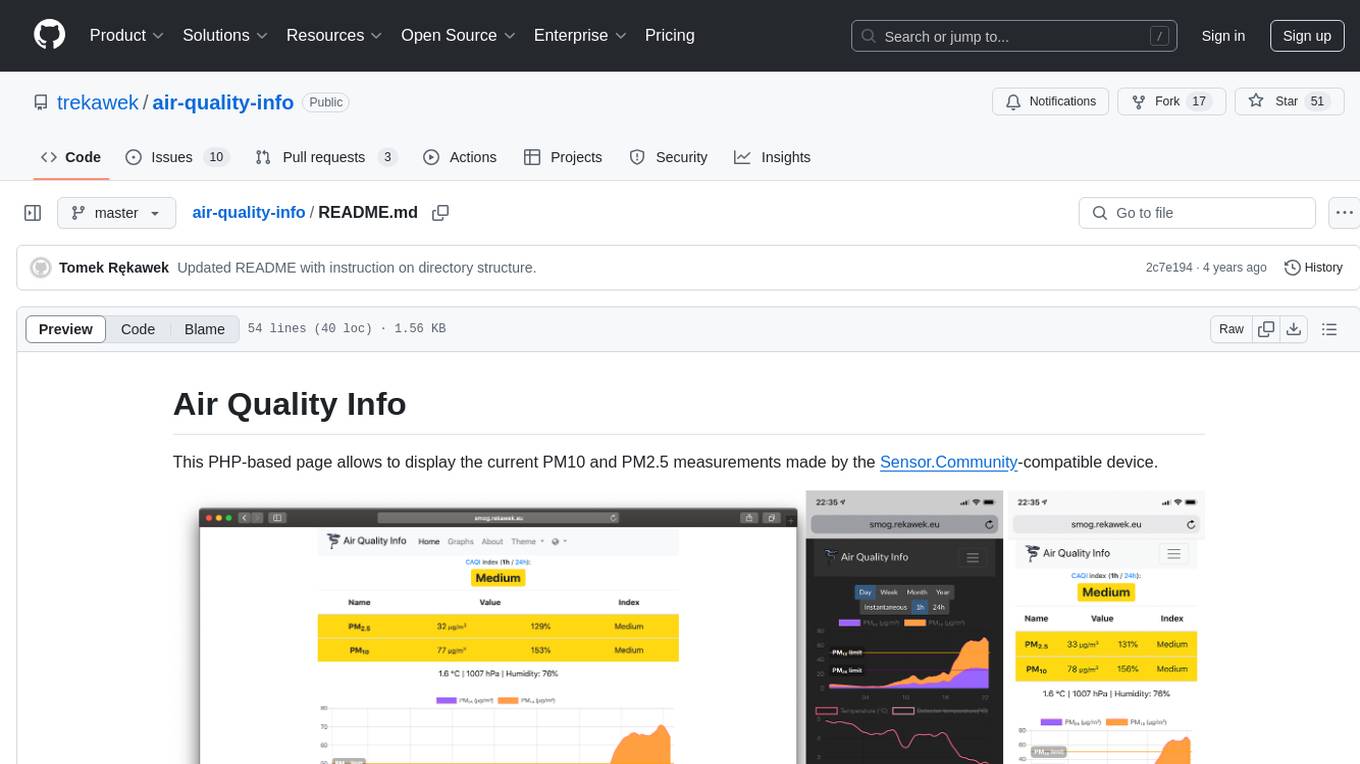
air-quality-info
Air Quality Info is a PHP-based page that displays current PM10 and PM2.5 measurements from Sensor.Community-compatible devices. It features a clean interface, stores records in MySQL, renders graphs with ChartJS, supports multiple devices, offers locale support, and functions as a Progressive Web App. The project setup involves creating directory structures, setting permissions, and starting Docker containers. The admin dashboard is accessible at http://aqi.eco.localhost:8080/, while the Air Quality Info pages use a specific naming schema. The project is supported by Nettigo Air Monitor, Sensor.Community, and a forum thread in Polish.
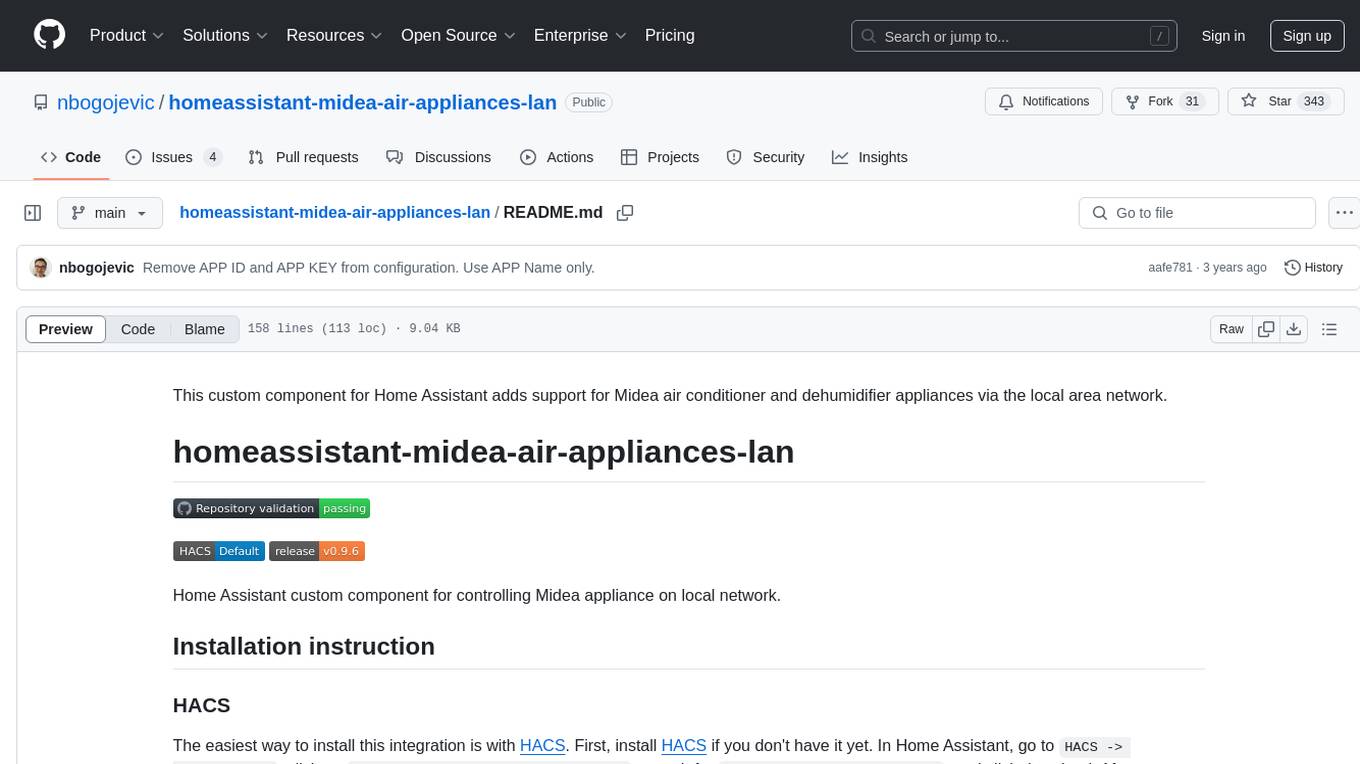
homeassistant-midea-air-appliances-lan
This custom component for Home Assistant adds support for controlling Midea air conditioner and dehumidifier appliances via the local area network. It provides integration for various Midea appliances, allowing users to control settings such as humidity levels, fan speed, and more through Home Assistant. The component supports multiple protocols and entities for different appliance models, offering a comprehensive solution for managing Midea appliances on the local network.
For similar jobs

airgradient_esphome
ESPHome yaml files for AirGradient devices to maintain the research and accuracy of AirGradient sensors, while also gaining the benefits of ESPHome/HomeAssistant for easy to use switches, buttons, configurations, and dashboards. Maintains the ability to also send data to the AirGradient Dashboard, which can also be disabled/removed to keep all data local.






